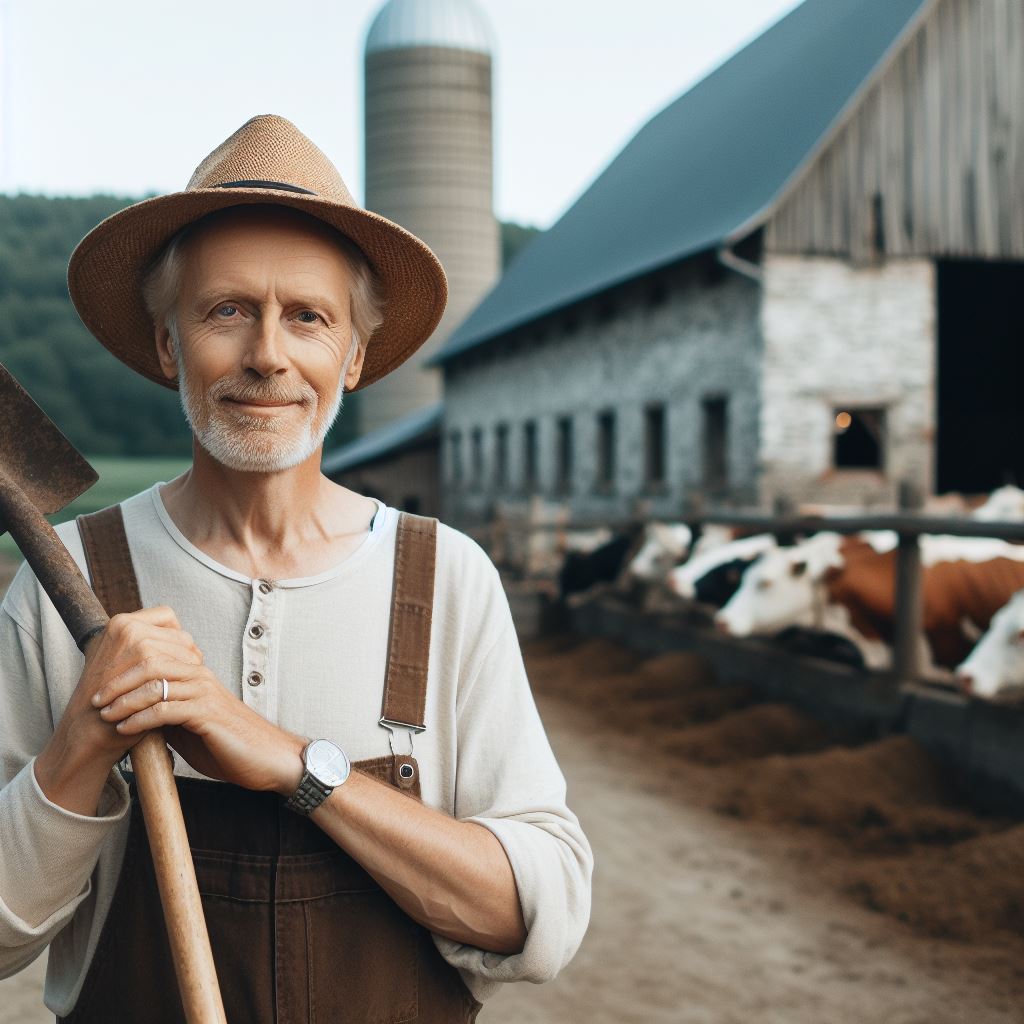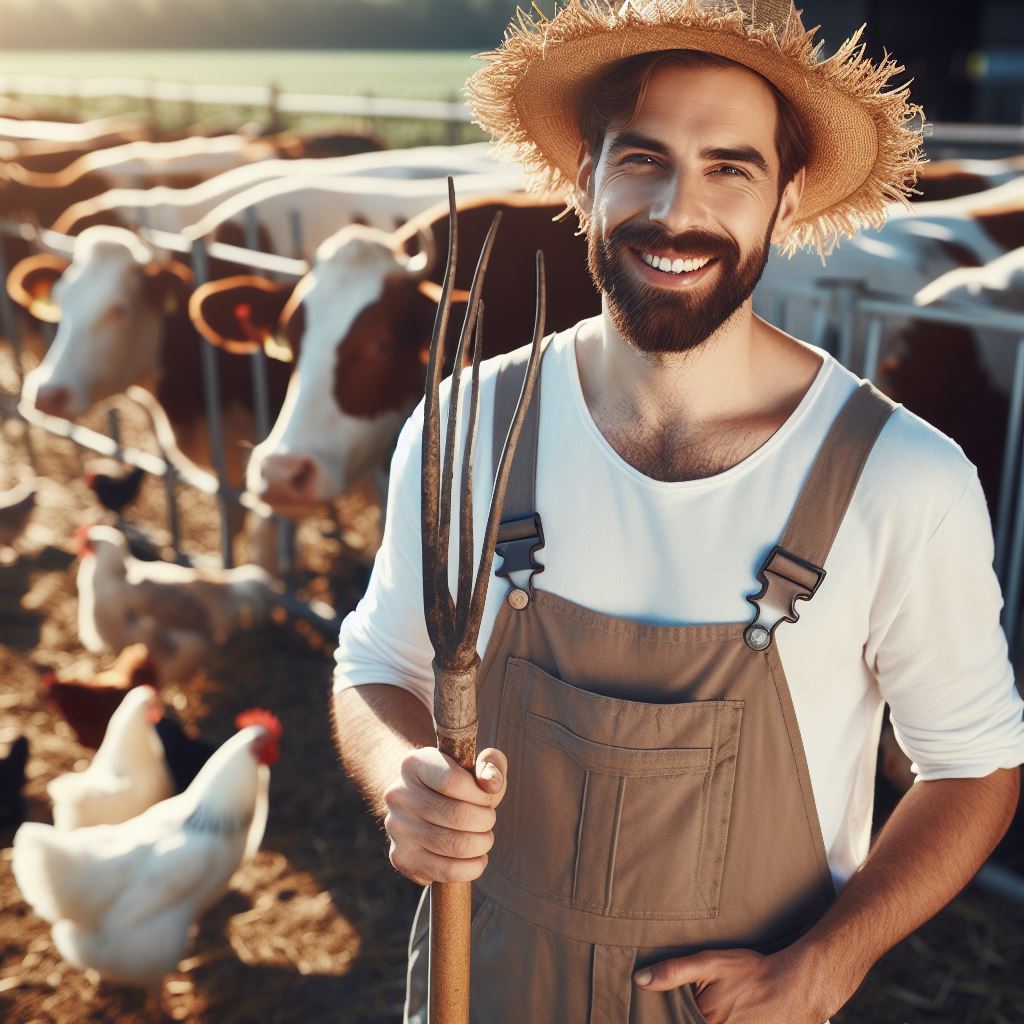Introduction
Disease prevention is crucial in effective cattle management, as it can greatly impact herd health and productivity.
By implementing preventive measures, farmers can reduce disease risks and protect their investment.
Maintaining a healthy herd is essential for agricultural efficiency and profitability.
Disease outbreaks can lead to significant economic losses, including reduced milk production, impaired fertility, and increased mortality rates.
Additionally, preventing diseases in cattle is crucial for public health.
Certain diseases can be transmitted from animals to humans, posing a risk to both farmers and consumers.
Therefore, proactive prevention measures are essential to avoid such risks.
Managing cattle involves understanding and addressing various aspects of animal health, including disease prevention.
This includes implementing strategies to control infectious diseases, such as vaccinations, biosecurity protocols, and proper nutrition.
Regular veterinary check-ups and diagnostic testing play a vital role in identifying diseases and preventing outbreaks.
By closely monitoring the herd, farmers can detect health issues early on, allowing for prompt treatment and prevention of further spread.
Moreover, implementing effective biosecurity measures helps reduce the introduction and transmission of diseases.
This includes restricting animal movement, maintaining clean and sanitized facilities, and minimizing contact with other herds.
In summary, disease prevention is a fundamental component of cattle management.
By prioritizing preventive measures, farmers can safeguard their herd’s health, ensure optimal productivity, and mitigate risks to public health.
Transform Your Agribusiness
Unlock your farm's potential with expert advice tailored to your needs. Get actionable steps that drive real results.
Get StartedUnderstanding Common Cattle Diseases
Cattle diseases can have detrimental effects on herds, impacting production and profitability.
It is essential for farmers and ranchers to be familiar with common bacterial, viral, and parasitic diseases that affect cattle.
By understanding these diseases and implementing appropriate disease prevention measures, herd health can be effectively managed, resulting in healthier and more productive cattle.
Common Bacterial Diseases
- Bovine Respiratory Disease Complex (BRD): caused by bacteria like Mannheimia haemolytica and Pasteurella multocida, leading to respiratory distress and reduced weight gain in cattle.
- Foot Rot: caused by bacteria like Fusobacterium necrophorum, resulting in lameness and decreased mobility in cattle.
Viral Diseases
- Infectious Bovine Rhinotracheitis (IBR): caused by Bovine Herpesvirus 1, leading to respiratory issues, reproductive problems, and even death.
- Bovine Viral Diarrhea (BVD): caused by Bovine Viral Diarrhea Virus, causing diarrhea, respiratory issues, reproductive disorders, and weak calves.
Common Parasitic Diseases
- Internal Parasites: Examples include gastrointestinal worms (Ostertagia ostertagi) and liver flukes, leading to poor growth, reduced feed efficiency, anemia, and even death.
- External Parasites: Examples include lice, ticks, and flies, causing irritation, skin disorders, reduced milk production, and weight loss.
Impact on Herds
Bacterial, viral, and parasitic diseases can have severe consequences for cattle herds:
- Decreased Reproductive Performance: Diseases like IBR and BVD can significantly affect fertility rates and lead to abortion or weak calves.
- Reduced Weight Gain: BRD and internal parasites hinder proper nutrition absorption, resulting in weight loss and decreased growth rates.
- Increased Mortality: Untreated bacterial and parasitic diseases can be fatal, leading to significant financial losses for farmers.
- Reduced Milk Production: External parasites such as flies and ticks can cause stress to cows, affecting milk quality and quantity.
- Negative Economic Impact: Cattle diseases necessitate medical treatments, decreased production, and potential culling, leading to financial losses.
Disease Prevention Tips
Prevention is crucial to minimize the occurrence of cattle diseases.
Here are some preventive measures for managing cattle health effectively:
- Vaccinations: Follow a veterinarian’s vaccination schedule to protect against viral diseases like IBR and BVD.
- Proper Nutrition: Provide a well-balanced diet to strengthen the immune system and improve overall health.
- Biosecurity Measures: Implement strict biosecurity protocols to prevent disease introduction and spread to the herd.
- Regular Monitoring: Monitor cattle closely for signs of illness and promptly isolate any animals showing symptoms.
- Parasite Control: Develop a deworming program to control internal parasites, and use appropriate treatments for external parasites.
- Hygiene Practices: Maintain clean and hygienic housing conditions to reduce the risk of bacterial infections like BRD and foot rot.
By adopting these disease prevention strategies and understanding the impact of common cattle diseases, farmers can ensure the well-being and productivity of their herds.
Regular veterinary consultations and proactive management practices play vital roles in effectively managing cattle health.
Remember, prevention is always better than cure in maintaining healthy livestock.
Read: Deer Farming: Genetics for Superior Antlers
Implementing Biosecurity Measures in Cattle Farming
Implementing these biosecurity measures aids in protecting the farm from various infectious diseases and improves overall productivity.
It is critical to establish a comprehensive biosecurity plan based on these guidelines to prevent disease introduction and ensure the health of the cattle.
The concept of biosecurity in cattle farming
By explaining the concept of biosecurity in cattle farming, farmers can understand the importance of disease prevention.
Biosecurity refers to the practices and protocols implemented to reduce the risk of disease introduction and spread within a livestock operation.
Practical steps for preventing disease introduction
Here we outline practical steps that can be taken to ensure biosecurity on a cattle farm.
Quarantine procedures for new cattle
- Separate newly arrived cattle from the main herd for a specific period, typically 30 days.
- During this quarantine period, closely observe the new cattle for any signs of disease.
- Perform veterinary checks and necessary tests to ensure they are free from infections.
Minimizing contact with wild animals
- Secure the perimeter of the farm with sturdy fencing to prevent wild animals from entering.
- Regularly inspect the fences and promptly repair any breaches or damages.
- Clear vegetation and bushes around the farm to discourage wild animal habitats.
Restricting farm visitors and equipment
- Implement strict protocols for farm visitors, including veterinarians, suppliers, or workers.
- Limit access to designated areas and ensure proper hygiene practices such as handwashing and boot disinfection.
- Regularly clean and disinfect farm equipment to avoid any potential contamination.
Proper manure management
- Develop a proper manure management plan to minimize disease transmission and environmental pollution.
- Regularly remove manure from barns and pastures to reduce the risk of spreading pathogens.
- Compost or properly treat manure to kill potential pathogens before using it as fertilizer.
In general, implementing biosecurity measures is crucial for managing cattle diseases and preventing their introduction to the farm.
By following quarantine procedures, minimizing contact with wild animals, restricting farm visitors and equipment, and practicing proper manure management, farmers can safeguard their herds.
Biosecurity is an essential component of successful cattle farming and plays a significant role in maintaining a healthy and productive herd.
Read: Turkey Genetics: Raising Robust Birds
Vaccination strategies
Vaccination is a crucial aspect of managing cattle as it plays a pivotal role in preventing diseases.
Here are some important points to consider:
Importance of Vaccinations
- Vaccinations help build immunity and protect cattle from a wide range of diseases.
- Preventing diseases through vaccination can minimize economic losses and improve overall herd health.
- Cattle that are properly vaccinated have a reduced risk of contracting and spreading diseases.
Essential Vaccines for Cattle Diseases
- Brucellosis: Vaccination against brucellosis is crucial to prevent this highly contagious bacterial infection.
- Blackleg: Providing vaccines for blackleg is vital as it can cause sudden death in young cattle.
- Botulism: Vaccinating against botulism is essential to prevent paralysis and death caused by Clostridium botulinum toxin.
- Leptospirosis: Vaccines for leptospirosis help protect against the bacterial infection caused by the Leptospira bacteria.
- Infectious Bovine Rhinotracheitis (IBR) and Bovine Viral Diarrhea (BVD): Vaccinating against these viral diseases helps prevent respiratory and reproductive issues.
Vaccination Schedules and Administration Methods
Follow these guidelines for effective vaccination schedules and administration methods:
- Consult with a veterinarian to determine the appropriate vaccination program for your cattle.
- Consider factors such as age, geographical location, herd size, and disease prevalence when developing a vaccination schedule.
- Administer vaccines either via subcutaneous (under the skin) or intramuscular (into the muscle) injections.
- Ensure proper handling and storage of vaccines to maintain their efficacy.
- Keep detailed records of all vaccinations, including dates, types of vaccines, and identification of vaccinated cattle.
Remember, proper vaccination protocols can help minimize the risk of diseases and promote healthier cattle.
In addition to vaccinations, it’s important to implement other disease prevention measures such as:
Showcase Your Farming Business
Publish your professional farming services profile on our blog for a one-time fee of $200 and reach a dedicated audience of farmers and agribusiness owners.
Publish Your Profile- Quarantining new animals to prevent the introduction of infectious diseases.
- Maintaining good hygiene practices, including regular cleaning and disinfection of housing areas.
- Practicing biosecurity measures to limit the potential spread of diseases within and between herds.
- Monitoring cattle regularly for signs of illness and promptly isolating and treating sick animals.
- Providing a well-balanced diet and proper nutrition to support strong immune systems.
By following these disease prevention tips, you can help ensure the health and well-being of your cattle and minimize the risk of outbreaks.
Read: Llama & Alpaca Breeding: Genetic Tips

Maintaining a clean and healthy environment is crucial for preventing diseases in cattle
Importance of clean housing and pastures for disease prevention
A clean housing and pasture are of utmost importance in disease prevention.
Proper ventilation is also necessary to reduce the risk of airborne diseases and to promote a healthy environment.
Regularly inspect and maintain the fence surrounding the pasture to prevent any escape of the cattle.
Proper cleaning and disinfection procedures
Regular cleaning and disinfection procedures should be implemented to maintain a hygienic environment.
This includes thoroughly cleaning all surfaces, equipment, and water sources used by the cattle.
Effective disinfectants should be used according to their specific instructions to ensure optimal results.
Effective strategies for waste management and pest control
- Waste management plays a significant role in preventing disease transmission.
- Manure should be promptly removed from the housing area and properly disposed of.
- Composting the manure can help reduce the risk of diseases and provide a beneficial source of fertilizer.
- Effective pest control measures should be implemented to minimize the risk of disease transmission.
- This includes managing flies, ticks, and other pests that can carry and spread diseases.
- Using insecticides, fly traps, and maintaining clean feeding and water areas can significantly reduce pest populations.
- Regular monitoring of cattle health is essential for early detection and prevention of diseases.
- Necessary vaccinations and deworming should be administered on schedule to ensure that the cattle are protected.
- Proper nutrition is vital for maintaining a strong immune system in cattle.
- High-quality feed, adequate water supply, and proper supplementation should be provided to promote overall health.
- Keep records of all vaccinations, treatments, and any other health-related measures taken for each individual animal.
- This information will be valuable in tracing back any potential disease outbreaks and will aid in future prevention.
- It is crucial to prevent the introduction of new animals without proper quarantine and testing.
- This helps prevent the spread of infectious diseases and ensures the health of the existing herd.
- Regular veterinary inspections should be scheduled to monitor the overall health and well-being of the cattle.
- In case of any signs of illness, immediate isolation and appropriate treatment should be initiated.
- Training farm staff on good biosecurity practices and disease prevention is essential.
- Educate them about the importance of hygiene, proper handling of equipment, and the use of personal protective equipment.
- Strict protocols should be implemented for visitors to prevent any potential introduction of diseases to the cattle.
By following these disease prevention tips, farmers can create a clean and healthy environment for their cattle.
This will help protect their investment, increase productivity, and ensure the welfare of the animals.
Read: Rabbit Genetics: Breeding for Health & Size
Improving Cattle Nutrition
The relationship between nutrition and immunity in cattle
In order to prevent diseases in cattle, it is crucial to focus on improving their nutrition.
A well-balanced diet can greatly enhance the immune function of cattle, making them more resistant to various diseases.
Here are some recommendations for balanced diets to enhance immune function in cattle:
Recommendations for balanced diets to enhance immune function
- Provide a Variety of Feed: Cattle should have access to a diverse range of forages and grains. This ensures that they receive a wide array of essential nutrients, vitamins, and minerals necessary for a strong immune system.
- Balanced Ratio of Nutrients: It is important to maintain an appropriate balance of nutrients in their diet. This includes a proper ratio of carbohydrates, proteins, and fats. This balance aids in maintaining optimal health and immune function.
- Adequate Protein Intake: Including high-quality protein sources in the diet is crucial for cattle. It helps in building a strong immune system and facilitates the production of disease-fighting antibodies.
- Vitamin and Mineral Supplements: Cattle should receive adequate amounts of vitamins and minerals, either through natural forages or supplements. These essential nutrients play a vital role in strengthening the immune response of cattle.
- Water Quality: Ensuring clean and fresh water availability is essential for proper digestion, nutrient absorption, and overall health. Poor water quality can lead to various diseases and compromise the immune system.
- Prevent Overfeeding or Underfeeding: Maintaining the right level of feeding is crucial for cattle’s overall health and immune function. Overfeeding can lead to obesity and metabolic disorders, while underfeeding can weaken the immune system.
- Regular Feeding Schedule: Establishing a consistent feeding routine helps maintain the cattle’s metabolism and overall health. Irregular feeding patterns can stress the animals and negatively impact their immune function.
- Avoid Feed Contamination: Care must be taken to prevent contamination of feed with molds, toxins, or other harmful substances. Contaminated feed can cause diseases and weaken the immune system.
Potential supplements or additives for disease prevention
In addition to nutrition, certain supplements or additives can help prevent diseases in cattle:
- Probiotics: These beneficial bacteria aid in maintaining a healthy gut flora, which is essential for proper digestion and immune function.
- Prebiotics: These substances promote the growth of beneficial bacteria in the gut, improving the digestive process and enhancing the immune system.
- Antioxidants: Including antioxidants in the diet can help neutralize harmful free radicals in the body, protecting the immune system from damage.
- Essential Oils: Some essential oils, such as oregano oil, have antimicrobial properties and can be used as natural alternatives to synthetic antibiotics.
- Vaccinations: Regular vaccinations are crucial for preventing diseases in cattle. Consult with a veterinarian to determine the appropriate vaccination schedule for your herd.
By focusing on improving cattle nutrition and incorporating appropriate supplements, farmers can greatly enhance the immune function of their animals.
A strong immune system is the key to disease prevention and overall herd health.
Remember, a healthy and well-nourished cow is a resilient cow capable of withstanding various ailments.
Monitoring Cattle Health
Cattle are valuable assets for farmers and it is crucial to ensure their good health in order to maximize productivity and profit.
Regular health checks and observation play a vital role in disease prevention and maintaining cattle health.
In this blog section, we will discuss the importance of monitoring cattle health, signs of illness or disease to watch out for, and the role of veterinary professionals in this process.
Importance of Regular Health Checks and Observation
Regular health checks are essential to detect any potential health issues in cattle at an early stage.
This allows for timely intervention, preventing the spread of diseases and reducing treatment costs.
Moreover, regular monitoring enables farmers to maintain a record of their cattle’s health, allowing them to track any patterns or trends that may be indicative of underlying health concerns.
Signs of Illness or Disease to Watch Out For
Observing the behavior and physical condition of cattle is crucial for identifying signs of illness or disease.
Some common signs include changes in appetite, weight loss, lethargy, abnormal discharge from the eyes or nose, coughing, and lameness.
It is important to note any abnormal behavior or symptoms promptly and report them to a veterinary professional for further evaluation.
Highlighting the Role of Veterinary Professionals
Veterinary professionals play a pivotal role in maintaining cattle health.
They possess the necessary expertise to diagnose and treat various diseases, as well as provide guidance on preventive measures.
Regular consultation with veterinarians ensures that farmers receive proper advice on vaccination schedules, nutrition, and overall herd management.
Veterinary professionals are also equipped to perform specialized tests, such as fecal examinations and blood tests, to assess the health status of cattle accurately.
Tips for effective monitoring and maintenance of cattle health
To help farmers effectively monitor and maintain cattle health, here are some key tips and practices:
- Develop a routine: Establish a set schedule for regular health checks and observation of all animals in the herd.
- Keep accurate records: Maintain comprehensive records to track the health history of each individual animal, allowing for early detection of potential health concerns.
- Observe feeding habits: Pay attention to any sudden changes in appetite or abnormal feeding behavior, as it may be an early sign of illness.
- Monitor body condition: Regularly assess the body condition score of each animal to detect any weight loss or abnormal weight gain, which can be indicative of underlying health issues.
- Check for signs of discomfort: Observe signs of discomfort—excessive scratching, rubbing, or prolonged lying down, indicating potential skin conditions or health problems.
- Inspect feces and urine: Regularly observe the consistency, color, and smell of feces and urine, as changes in these can signal digestive or urinary tract disorders.
In closing, monitoring cattle health is essential for disease prevention and maintaining overall herd well-being.
By conducting regular health checks, observing for signs of illness, and involving veterinary professionals, farmers can ensure early detection and appropriate treatment.
Implementing these tips and practices will lead to better cattle health, improved productivity, and increased profitability for farmers.
Remember, a healthy herd is a happy and profitable one.
Conclusion
Managing cattle and preventing diseases is vital for the overall success of a herd.
By following the tips discussed in this blog post, such as regular vaccinations, proper nutrition, and maintaining clean environments, farmers can significantly reduce the risk of disease outbreaks.
Disease prevention is crucial because it not only ensures the health and well-being of individual animals but also protects the profitability and sustainability of the entire operation.
When diseases strike, they can lead to significant financial losses for farmers.
Showcase Your Farming Business
Publish your professional farming services profile on our blog for a one-time fee of $200 and reach a dedicated audience of farmers and agribusiness owners.
Publish Your ProfileTherefore, it is essential for cattle farmers to be proactive in taking preventive measures, such as regular veterinary visits, biosecurity protocols, and quarantining new animals.
These actions can help maintain healthy herds, minimize the spread of diseases, and increase productivity.
By implementing strong disease prevention strategies, farmers can also contribute to the overall health and welfare of the livestock industry.
Preventing diseases not only benefits individual farms but also helps maintain consumer confidence in the quality and safety of beef products.
Effective cattle management includes prioritizing disease prevention.
Recap the main points, emphasize disease prevention’s significance, and empower farmers to make informed decisions for cattle health.
Remember, preventing diseases is always better than dealing with outbreaks, so let’s work together to maintain healthy and thriving herds!




